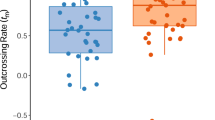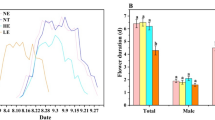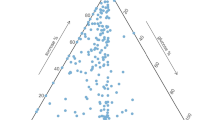Abstract
Floral and reproductive traits frequently influence pollinator behaviour and plant reproductive success and are therefore thought to be under selection. However, for wild plant populations there is little information on the amount of genetic variation for such traits. We estimated broad- and narrow-sense heritability of floral and reproductive traits for two populations of the perennial wildflower Penstemon centranthifolius, using a paternal half-sib crossing design in one case, and clonal propagation of ramets from different genets in the other. In both designs, most traits were significantly heritable, including nectar production, corolla length and width, inflorescence length and total flower production. Flowering date was significantly heritable for the crosses, but not for the clones, while nectar sugar concentration was not significantly heritable in either design. Genetic correlations were in some cases strong, and in some cases differed greatly from the corresponding phenotypic correlations. These results indicate that P. centranthifolius harbours a large reservoir of genetic variance which could support an evolutionary response to phenotypic selection.
Similar content being viewed by others
Article PDF
References
Bolten, A B, Feinsinger, P, Baker, H G, and Baker, I. 1979. On the calculation of sugar concentration in flower nectar. Oecologia, 41, 301–304.
Broyles, S B, and Wyatt, R. 1990. Paternity analysis in a natural population of Asclepias exaltata: multiple paternity, functional gender, and the ‘pollen donation hypothesis’. Evolution, 44, 1454–1468.
Campbell, D C. 1989. Measurements of selection in a hermaphroditic plant: variation in male and female pollination success. Evolution, 43, 318–334.
Campbell, D C, Waser, N M, Price, M V, Lynch, E A, and Mitchell, R J. 1991. A mechanistic analysis of phenotypic selection: pollen export and corolla width in Ipomopsis aggregate. Evolution, 45, 1458–1467.
Cresswell, J E, and Galen, C. 1991. Frequency-dependent selection and adaptive surfaces for floral character combinations: the pollination of Polemonium viscosum. Am Nature, 138, 1342–1353.
Faegri, K, and van der Pijl, L. 1971. The Principles of Pollination Ecology, 2nd rev. edn. Pergamon, Oxford.
Falconer, D S. 1981. Introduction to Quantitative Genetics, 2nd edn. Longman, New York, pp. 115–181.
Galen, C, and Stanton, M L. 1989. Bumble bee pollination and floral morphology: factors influencing pollen dispersal in the alpine sky pilot Polemonium viscosum (Polemoniaceae). Am J Bot, 76, 419–426.
Hawkins, R P. 1971. Selection of height of nectar in the corolla tube of English singlecut red clover. J Agric Sci, 77, 351–361.
Hill, W G, and Thompson, R. 1978. Probabilities of non-positive definite between group or genetic covariance matrices. Biometrics, 34, 429–439.
Kenoyer, L A. 1917. Environmental influences on nectar secretion. Bot Gaz, 63, 249–265.
Lande, R, and Arnold, S J. 1983. The measurement of selection on correlated characters. Evolution, 37, 1210–1226.
Mazer, S J, and Schick, C T. 1991. Constancy of population parameters for life-history and floral traits in Raphanus sativus L. II. Effects of planting density on phenotype and heritability estimates. Evolution, 45, 1888–1907.
Meyer, K, and Thompson, R. 1984. Bias in variance and covariance component estimators due to selection on a correlated trait. Sonderdruck aus Zeitschrift für Tierzüchtung und Züchtungsbiologie Bd, 101, 33–50.
Mitchell, R J. 1989. Is Penstemon centranthifolius truly hummingbird pollinated? Cromosoma, 15, 1–9.
Mitchell, R J. 1993. Adaptive significance of Ipomopsis aggregata nectar production rate: observational and experimental studies in the field. Evolution, 47, 25–35.
Mitchell-Olds, T, and Rutledge, J J. 1986. Quantitative genetics in natural plant populations: a review of the theory. Am Nature, 127, 379–402.
Munz, P A, and Keck, D D. 1959. A California Flora. University of California Press, Berkeley.
Pedersen, M W. 1953. Seed production in alfalfa as related to nectar production and honeybee visitation. Botanical Gazette, 115, 124–138.
Pleasants, J M. 1983. Nectar production patterns in Ipomopsis aggregata (Polemoniaceae). Am J Bot, 60, 1468–1475.
Plowright, R C. 1987. Corolla depth and nectar concentration: an experimental study. Can J Bot, 63, 1011–1113.
Pyke, G H, and Waser, N M. 1981. The production of dilute nectars by hummingbird and honeyeater flowers. Biotropica, 13, 260–270.
Rathcke, B J. 1992. Nectar distributions, pollinator behaviour, and plant reproductive success. In: Hunter, M. D., Ohgushi, T. and Price, P. W. (eds.) Effects of Resource Distribution on Animal-Plant Interactions, Academic Press, New York, pp. 113–138.
Real, L A, and Rathcke, B J. 1991. Individual variation in nectar production and its effects on fitness in Kalmia latifolia. Ecology, 72, 149–155.
Shaw, R G. 1987. Maximum-likelihood approaches applied to quantitative genetics of natural populations. Evolution, 41, 812–826.
Shaw, R G, and Plantenkamp, G A J. ( 1993). Quantitative genetics of response to competitors in Nemophila menziesii: a greenhouse study. Evolution (in press).
Shaw, R G, and Shaw, F H. 1992. Quercus: programs for quantitative genetic analysis using maximum likelihood. Published electronically on Internet, available via anonymous ftp from ftp.bio.indiana.edu; directory path biology/quantgen/quercus.
Shore, J S, and Barrett, S C H. 1990. Quantitative genetics of floral characters of homostylous Turnera ulmifolia var. angustifolia Willd. (Turneraceae). Heredity, 64, 105–112.
Shuel, R W. 1952. Some factors affecting nectar secretion in red clover. Plant Physiol, 57, 95–110.
Stanton, M L, Snow, A A, and Handel, S N. 1986. Floral evolution: attractiveness to pollinators increases male fitness. Science, 232, 1625–1627.
Straw, R M. 1955. Floral ecology and evolution in Penstemon Ph.D. thesis, Rancho Santa Ana Botanic Garden, Claremont, CA.
Straw, R M. 1957. Adaptive morphology of the Penstemon flower. Evolution, 11, 112–119.
Teuber, L R, and Barnes, D K. 1979. Environmental and genetic influences on alfalfa nectar. Crop Sci, 19, 874–878.
Teuber, L R, Rincker, C M, and Barnes, D K. 1990. Seed yield characteristics of alfalfa populations selected for receptable diameter and nectar volume. Crop Sci, 30, 579–583.
Walker, A K, Barnes, D K, and Furgala, B. 1974. Genetic and environmental effects on quantity and quality of alfalfa nectar. Crop Sci, 14, 235–238.
Willis, J H, Coyne, J A, and Kirkpatrick, M. 1991. Can one predict the evolution of quantitative characters without genetics? Evolution, 45, 441–443.
Wyatt, R, and Shannon, T R. 1986. Nectar production and pollination of Asclepias exaltata. Syst Bot, 11, 326–334.
Zimmerman, M. 1983. Plant reproduction and optimal foraging: experimental nectar manipulations in Delphinium nelsonii. Oikos, 41, 57–63.
Zimmerman, M. 1988. Nectar production, flowering phenology, and strategies for pollination. In: Lovett-Doust, J. and Lovett-Doust, L. (eds) Plant Reproductive Ecology, Patterns and Strategies, Oxford University Press, Oxford, pp. 157–178.
Author information
Authors and Affiliations
Rights and permissions
About this article
Cite this article
Mitchell, R., Shaw, R. Heritability of floral traits for the perennial wild flower Penstemon centranthifolius (Scrophulariaceae): clones and crosses. Heredity 71, 185–192 (1993). https://doi.org/10.1038/hdy.1993.123
Received:
Issue date:
DOI: https://doi.org/10.1038/hdy.1993.123
Keywords
This article is cited by
-
The effects of nutrient addition on floral characters and pollination in two subalpine plants, Ipomopsis aggregata and Linum lewisii
Plant Ecology (2009)
-
Genetic constraints on floral evolution: a review and evaluation of patterns
Heredity (2006)
-
Heritability of nectar production in Echium vulgare
Heredity (2004)



